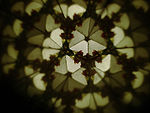Kaleidoscope: Difference between revisions
Jasper124c41 (talk | contribs) Fixed blatant advertising in external links, added link to kaleidica, alphabetized external links |
Jasper124c41 (talk | contribs) |
||
| Line 30: | Line 30: | ||
==External links== |
==External links== |
||
*[http://www.brewstersociety.com/ The Brewster Kaleidoscope Society] An international organization for kaleidoscope enthusiasts. |
*[http://www.brewstersociety.com/ The Brewster Kaleidoscope Society] An international organization for kaleidoscope enthusiasts. |
||
*[http://www.kaleidowonders.com/ Buy Kaleidoscopes] |
*[http://www.kaleidowonders.com/ Buy Kaleidoscopes] |
||
*[http://www.zefrank.com/dtoy_vs_byokal/index.html Custom three dimensional online kaleidoscope] |
*[http://www.zefrank.com/dtoy_vs_byokal/index.html Custom three dimensional online kaleidoscope] |
||
Revision as of 22:19, 11 February 2007




The kaleidoscope is a toy containing small, brightly-colored tumbling objects, and a set of mirrors which reflect the view of the tumbling objects into repeating, symmetric patterns. The tumbling objects — typically coloured beads or pebbles — are enclosed in a transparent or translucent chamber mounted at one end of a tube; the viewer looks in the other end of the tube. Mounted lengthways along the inside of the tube are either two or three striplike mirrors which combine and form the image.
If the mirrors are mounted at a 45° angle to each other, eight duplicate views are created. A 60° angle leads to six views, or 90° to four. As the object chamber is rotated, the tumbling of the objects within presents the viewer with an infinitely-varying succession of colors and patterns. Although the composition within one triangular cell of the view is arbitrary, the overall pattern is beautifully symmetric because of the reflections in the mirrors. A two-mirror model yields a single pattern isolated against a black background, while a three-mirror (closed triangle) model yields an infinitely-repeating pattern that seems to fill the entire field of view.
Kaleidoscope tubes can be made inexpensively of cardboard, or elegantly out of brass, wood, or other fine materials. The tumbling objects can be beads, semiprecious stones, chips of glass, or almost any imaginable substance. Sometimes the object chamber is filled with liquid so that the items float and move in a more fluid manner. Some high-quality kaleidoscopes have lenses at one or both ends to gather light and/or sharpen the image.
For a 2D symmetry group a kaleidoscopic point is a point of intersection of two or more lines of reflection symmetry. In the case of a discrete group the angle between consecutive lines is 180°/n for an integer n≥2. At this point there are n lines of reflection symmetry, and the point is a center of n-fold rotational symmetry. See also symmetry combinations.
History
Known to the ancient Greeks, it was reinvented by the Scot Sir David Brewster in 1816 while conducting experiments on light polarization, and it was patented in 1817. The initial design was made from a tube in which Brewster placed pairs of mirrors at one end, and pairs of translucent disks at the other end. Between the two, he placed the beads. Initially intended as a science tool, it was quickly copied as a toy. Brewster believed he would make money from his popular invention. However, a fault in his patent allowed others to copy his invention. In America, Charles Bush popularized the kaleidoscope. Today, these early products often sell for over $1,000. Cozy Baker collected kaleidoscopes and wrote books about the artists who were making them in the 1970s through 2000. Cozy is credited with energizing a renaissance in kaleidoscope making in America. Craft galleries often carry a few, while others specialize in them and carry dozens of different types from different artists and craftspeople. Many of the kaleidoscopes being made today are categorized as art, sculpture or jewelery.
Background
For some background on the geometry of the kaleidoscope, see Reflection group.
See also
External links
- The Brewster Kaleidoscope Society An international organization for kaleidoscope enthusiasts.
- Buy Kaleidoscopes
- Custom three dimensional online kaleidoscope
- Kaleider Digital Imagery
- How to Build a Kaleidoscope
- The Kaleidica digital kaleidoscope
- Kaleidoscope artists and events
- Kaleidoscopes and Art Glass
- Kaleidoscope DVD
- Kaleidoscope History
- Kaleidoscope Mirror Designs
- Kaleidoscopes and Teleidoscopes Xenlite Kaleidoscopes and Teleidoscopes
- Literary and Philosophical Remarks
- Wand Kaleidocopes
